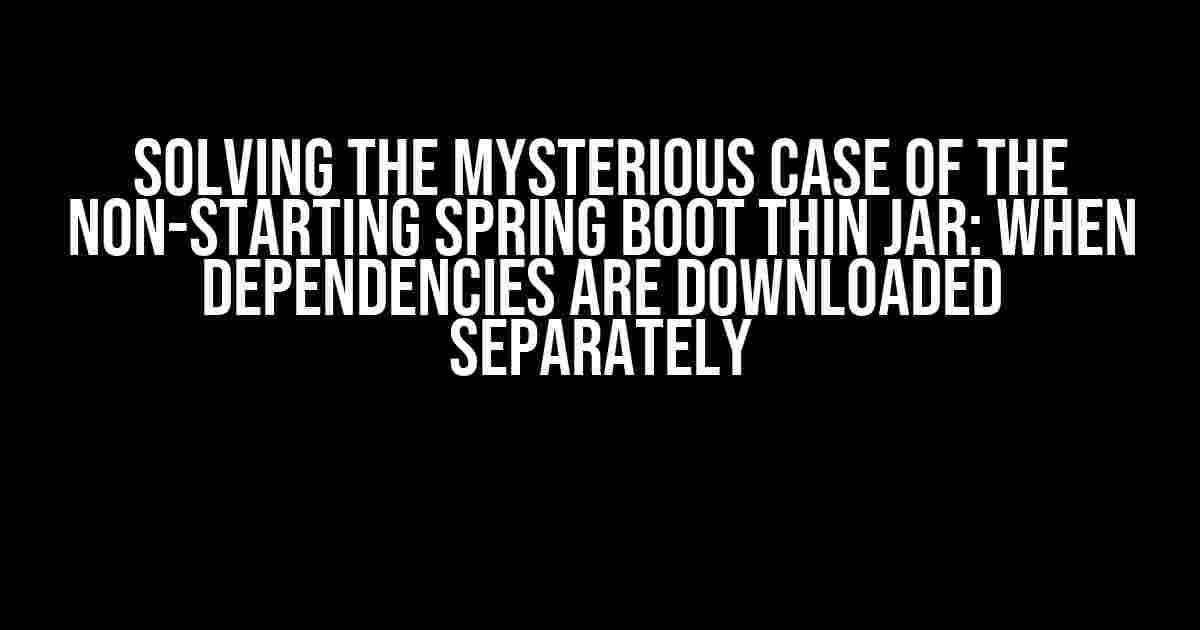Are you stuck in a puzzling predicament where your Spring Boot thin JAR refuses to start when dependencies are downloaded separately? Fear not, dear developer! This article is here to guide you through the troubleshooting process and provide a clear, step-by-step solution to get your thin JAR up and running in no time.
What is a Spring Boot Thin JAR, and Why Does it Matter?
A Spring Boot thin JAR is a lightweight JAR file that contains only your application’s classes and resources, without any dependencies. This makes it ideal for containerized environments, such as Docker, where you can download and install dependencies separately. However, this approach can lead to issues when it comes to starting your application.
The Problem: Dependencies Not Found
When you download dependencies separately, they might not be available on the classpath, causing your Spring Boot application to fail to start. This is because the thin JAR doesn’t include the dependencies, and the classloader can’t find them.
Step 1: Identify the Issue
To troubleshoot the problem, let’s first identify the symptoms. Check your application’s logs for errors related to missing dependencies or classes not found. Look for messages like:
java.lang.NoClassDefFoundError: org/springframework/boot/context.SpringBootTest
at com.example.MyApplication.main(MyApplication.java:12)
Caused by: java.lang.ClassNotFoundException: org.springframework.boot.context.SpringBootTest
at java.net.URLClassLoader.findClass(URLClassLoader.java:382)
at java.lang.ClassLoader.loadClass(ClassLoader.java:424)
at sun.misc.Launcher$AppClassLoader.loadClass(Launcher.java:349)
at java.lang.ClassLoader.loadClass(ClassLoader.java:357)
... 1 more
This error indicates that the `@SpringBootTest` annotation, which is part of the Spring Boot framework, is not found on the classpath.
Step 2: Verify Dependency Downloads
Confirm that you have downloaded the required dependencies separately. Check your project’s directory structure and verify that the dependencies are present in the correct location.
Example Directory Structure:
| Directory | Contents |
|---|---|
| app | my-app.jar (thin JAR) |
| lib |
|
Step 3: Update the Classpath
To fix the issue, you need to update the classpath to include the downloaded dependencies. You can do this by adding the following configuration to your `application.properties` file:
java.class.path=app/my-app.jar:lib/*
This configuration tells the Java runtime to include the `my-app.jar` file and all JAR files in the `lib` directory in the classpath.
Step 4: Run Your Application
With the updated classpath configuration, you can now run your Spring Boot application using the following command:
java -jar app/my-app.jar
Your application should now start successfully, and you should see the familiar Spring Boot logo in your console:
. ____ _ __ _ _ /\\ / ___'_ __ _ _(_)_ __ __ _ \ \ \ \ ( ( )\___ | '_ | '_| | '_ \/ _` | \ \ \ \ \\/ ___)| |_)| | | | | || (_| | ) ) ) ) ' |____| .__|_| |_|_| |_\__, | / / / / =========|_|==============|___/=/_/_/ :: Spring Boot :: (v2.3.1.RELEASE)
Conclusion
Solving the mystery of the non-starting Spring Boot thin JAR when dependencies are downloaded separately requires a combination of troubleshooting skills, attention to detail, and a clear understanding of the classpath. By following the steps outlined in this article, you should now be able to get your thin JAR up and running, even when dependencies are downloaded separately.
Bonus Tip: Using the Spring Boot Maven Plugin
If you’re using Maven to build your Spring Boot project, you can use the Spring Boot Maven Plugin to generate a thin JAR with dependencies included. This eliminates the need to download dependencies separately and simplifies the process of creating a executable JAR file.
<build>
<plugins>
<plugin>
<groupId>org.springframework.boot</groupId>
<artifactId>spring-boot-maven-plugin</artifactId>
<configuration>
<classifier>exec</classifier>
</configuration>
</plugin>
</plugins>
</build>
This plugin configuration will generate a `my-app-exec.jar` file that includes all dependencies, making it easy to distribute and run your application.
Final Thoughts
In conclusion, troubleshooting a Spring Boot thin JAR that refuses to start when dependencies are downloaded separately requires patience, persistence, and a solid understanding of the underlying mechanisms. By following the steps outlined in this article, you should be able to overcome this challenge and get your application up and running in no time. Remember to stay calm, think logically, and don’t be afraid to dig deeper into the mysteries of the classpath.
Frequently Asked Question
Get ready to tackle the most common conundrums surrounding Spring Boot Thin JARs!
Why does my Spring Boot Thin JAR not start when I download dependencies separately?
This issue often arises when the dependencies are not packaged correctly in the Thin JAR. Since the dependencies are downloaded separately, they might not be included in the JAR file. To resolve this, ensure that the dependencies are properly packaged using the maven-jar-plugin or the spring-boot-maven-plugin.
How do I verify that my dependencies are correctly packaged in the Thin JAR?
You can verify this by extracting the contents of the Thin JAR file using a tool like jar -xvf your-jar-file.jar. Then, check if the dependencies are present in the extracted directory structure. If they’re not, revisit your build configuration to ensure that the dependencies are properly included.
What are some common mistakes to avoid when creating a Thin JAR for my Spring Boot application?
Common mistakes include not specifying the correct dependencies, incorrect configuration of the maven-jar-plugin, and forgetting to include the Spring Boot dependencies. Double-check your pom.xml file to ensure that all dependencies are correctly declared and configured.
Can I use the spring-boot-maven-plugin to create a Thin JAR for my Spring Boot application?
Yes, you can! The spring-boot-maven-plugin provides an easy way to create a Thin JAR for your Spring Boot application. By configuring the plugin correctly, you can ensure that the dependencies are properly packaged and the JAR file is executable.
What are the benefits of using a Thin JAR for my Spring Boot application?
Thin JARs offer several benefits, including reduced file size, faster startup times, and improved deployment flexibility. By excluding unnecessary dependencies, you can create a more efficient and compact JAR file that’s easier to distribute and deploy.

